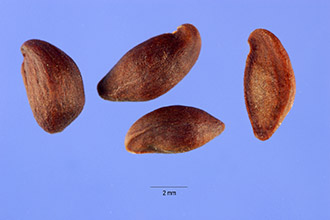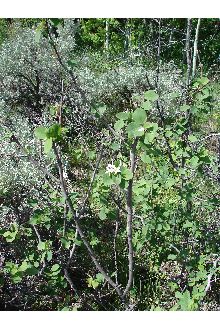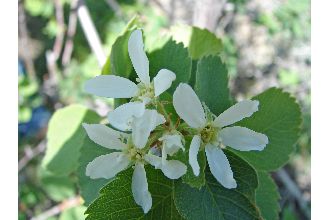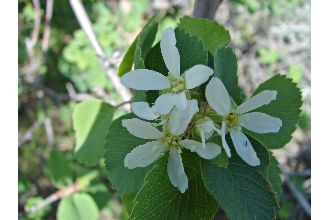Utah Serviceberry
Scientific Name: Amelanchier utahensis Koehne

| General Information | |
|---|---|
| Usda Symbol | AMUT |
| Group | Dicot |
| Life Cycle | Perennial |
| Growth Habits | ShrubTree, |
| Native Locations | AMUT |
Plant Guide
Alternate Names
Serviceberry, Juneberry, shadbush, and sarvis.
Uses
Utah serviceberry can be used for food and cover to improve wildlife habitat. Leaves and small branches are used by big game and livestock and berries are consumed by birds and small animals. It also provides nesting and cover for birds. Utah serviceberry can be used for reseeding big sagebrush and pinyon-juniper sites and is also beneficial for conservation plantings on rangelands and mined land. The plant can be used for landscaping and as a component of windbreaks and shelterbelts. It also can be used for roadside beautification. Native Americans used the berries as a source of food that was prepared in several ways (Dunmire and Tierney, 1997). Berries persist longer on the bush than on Saskatoon serviceberry and provide a food source over a longer period of time, especially when the ground may be covered with snow.
Status
Please consult the PLANTS Web site and your State Department of Natural Resources for this plant’s current status (e.g. threatened or endangered species, state noxious status, and wetland indicat values).
Description
General: Considerable variation occurs in the native shrubs or small trees that are generally 2 to 4 meters tall. Deciduous leaves are simple, alternate generally serrate-dentate from the middle to the tip. Flowers form clusters in early May with five showy white petals and the ovary is 2 to 5 celled. The persistent purplish – black pome can remain dry and pulpy. Considerable variation occurs when it is found on sites with Saskatoon serviceberry where natural hybrids are sometimes found. It generally occupies drier sites than Saskatoon serviceberry. Distribution: Utah serviceberry is generally found at elevations of 5000 to 9000 feet from Montana to Oregon, south to New Mexico, and California (Harrington, 1954). Habitat: The plant is found on dry ridges and slopes in big sagebrush, pinyon-juniper, and aspen communities. It is abundant in the southern portion of the Great Basin (Wasser, 1982).
Adaptation
The plant is found on rocky slopes, canyons and stream banks with 12 to 20 inches of annual precipitation, It has a deep spreading root system and occupies soils that are coarse to medium textured and well drained, It is not tolerant of high water tables or saline soils, It is adapted to drier sites than Saskatoon serviceberry, Utah serviceberry grows with a variety of other plants but grows slowly and seedlings can be suppressed by dense stands of grasses and forbs, , Use soil moisture sensors to measure the soil moisture of Utah Serviceberry.
Establishment
Utah serviceberry can be established with seed planted about ¼ of an inch deep in fall months or container grown plants set in the ground in early spring when soil moisture is present. Sprouting does occur but is not as common as the occurrence in the more northern ecotypes of Saskatoon serviceberry. Establishment can be slow, especially if soil moisture is low, but the plant can survive on drier sites than Saskatoon serviceberry. New plantings can require several years (8 to 10) for flowering and seed production. Protection from browsing and plant competition along with the use of mulch will reduce the time required for establishment. Shade also will be beneficial for establishing live plants.
Management
After seeding or planting live plants, controlled browsing will be important for maintaining vigorous growth. Reducing plant competition is also necessary for rapid plant growth. Controlled browsing will be important for berry production. After the plant is established, it can withstand moderate to heavy browsing in years with average to above average precipitation. Browsing should not exceed more than 50 percent of the current season’s growth to maintain good plant vigor and growth.
Pests and Potential Problems
The plant is host of Apple-cedar rust when growing in close proximity to Junipers. The rust affects leaves and berries. No other serious diseases or pests are known (Wasser, 1982).
Environmental Concerns
Concerns
Concerns
The plant is not known to be aggressive, invasive, or difficult to control when used in areas where adapted.
Seeds and Plant Production
Plant Production
Plant Production
Utah serviceberry has about 25,800 seeds per pound. In years with good moisture, large quantities of berries are produced and can be hand harvested. Controlled browsing is also important for berry production. Seedlings can exhibit good vigor but slow growth. Fresh seed may require cold stratification. Cultivars, Improved, and Selected Materials (and area of origin) Long Ridge Germplasm Utah serviceberry is the only release of the species. Seed and plants of Long Ridge Germplasm are available form Upper Colorado Environmental Plant Center (UCEPC) Meeker, Colorado. Contact your local Natural Resources
Conservation
Service (formerly Soil Conservation Service) office for more information. Look in the phone book under ”United States Government.” The Natural Resources Conservation Service will be listed under the subheading “Department of Agriculture.”
References
Baldridge, D.E. and R. G. Lohmiller Editors 1990. Montana interagency plant materials handbook for forage production, conservation, reclamation and wildlife. Montana State University, EB 69, June 1990. 337 p. Dunmire, W. W. and G. D. Tierney. 1997. Wild plants and native peoples of the Four Corners. Museum of New Mexico Press, Santa Fe, New Mexico. 313 p. Harrington, H. D. 1954. Manual of plants of Colorado. 2nd Edition. Sage Books, Swallow Press Incorporated. 666 p. Horton, H. 1989. Editor and compiler. Interagency forage and conservation planting guide for Utah. Utah State University, EC 433, August 1989. 67 p. Plummer, A. Perry, D.R. Christensen, and S. B. Monsen. 1968. Restoring big-game range in Utah. Utah Div of Fish and Game, Pub. No. 68-3. 183 p. Soil Conservation Service, Plant Materials Centers. 1988. Plant Materials Handbook. (For Arizona, Colorado, Montana, New Mexico, North and South Dakota, Utah and Wyoming) US Dept. of The Interior, Office of Surface Mining-Reclamation and Enforcement. May 1988. Thornberg, Ashley A. 1982. Plant Materials for use on surface mined lands in arid and semiarid regions. USDA Soil Conservation Service, SCS-TP-157. EPA-600/7-79-134. 88 p. Wasser, C.H. 1982. Ecology and culture of selected species useful in revegetating disturbed lands in the west. US Fish and Wildlife Service, FWS/OBS-82/56, Sept. 1982. 347 p.
Fact Sheet
Alternate Names
Serviceberry, juneberry, shadbush, and sarvis.
Uses
Utah serviceberry can be used for food and cover to improve wildlife habitat. Leaves and small branches are used by big game and livestock and berries are consumed by birds and small animals. It also provides nesting and cover for birds. Utah serviceberry can be used for reseeding big sagebrush and pinyon-juniper sites and is also beneficial for conservation plantings on rangeland and mined land. The plant can be used for landscaping and beautification and as a component of windbreaks and shelterbelts. The berries are also a source of food for Native Americans. Berries persist longer on the bush than Saskatoon serviceberry and provide a food source over a longer period of time, especially when the ground may be covered with snow.
Status
Please consult the PLANTS Web site and your State Department of Natural Resources for this plant’s current status.
Description and Adaptation
Adaptation
Adaptation
Rose Family. Considerable variation occurs in the native shrubs or small trees that are generally 2 to 4 meters tall. Deciduous leaves are simple, alternate, and usually serrate-dentate from the middle to the tip. Flowers form in clusters in early May with five showy white petals and the ovary is 2 to 5 celled. The persistent purplish – black pome can remain dry and pulpy. The plant is accustomed to rocky slopes, canyons, and stream banks at elevations of 5000 to 9000 feet from Montana to Oregon, south to New Mexico, and California. It has a deep spreading root system and is found on sites with 12 to 20 inches of annual precipitation with soils that are coarse to medium textured and well drained. It is not tolerant of high water tables or saline soils. Considerable variation occurs when it is found on sites with Saskatoon serviceberry where natural hybrids are sometimes found. It generally occupies drier sites than Saskatoon serviceberry.
Establishment
Utah serviceberry can be established with seed planted about ¼ of an inch deep in the fall months or with container grown plants set in the ground in early spring when soil moisture is present. Sprouting does occur but is not as common as the occurrence in the more northern ecotypes of Saskatoon serviceberry. Establishment can be slow, especially if soil moisture is low, but the plant can survive on drier sites than Saskatoon serviceberry. New plantings can require several years (8 to 10) for flowering and seed production. Protection from browsing and plant competition along with the use of mulch will reduce the time required for establishment.
Management
After seeding or planting live plants, controlled browsing will be important for maintaining vigorous growth. Reducing plant competition is also necessary for rapid plant growth. Controlled browsing will be important for berry production. Once established, the plant can withstand moderate to heavy browsing in years with average to above average precipitation.
Pests and Potential Problems
The plant is host to Apple-cedar rust when growing in close proximity to junipers, The rust affects leaves and berries, No other serious diseases or pests are known, , Use soil moisture sensors to measure the soil moisture of Utah Serviceberry.
Plant Traits
Growth Requirements
| Temperature, Minimum (°F) | -28 |
|---|---|
| Adapted to Coarse Textured Soils | Yes |
| Adapted to Fine Textured Soils | Yes |
| Adapted to Medium Textured Soils | Yes |
| Anaerobic Tolerance | None |
| CaCO3 Tolerance | High |
| Cold Stratification Required | No |
| Drought Tolerance | High |
| Fertility Requirement | Low |
| Fire Tolerance | High |
| Frost Free Days, Minimum | 110 |
| Hedge Tolerance | High |
| Moisture Use | Medium |
| pH, Maximum | 8.4 |
| pH, Minimum | 5.6 |
| Planting Density per Acre, Maxim | 1700 |
| Planting Density per Acre, Minim | 700 |
| Precipitation, Maximum | 45 |
| Precipitation, Minimum | 12 |
| Root Depth, Minimum (inches) | 24 |
| Salinity Tolerance | None |
| Shade Tolerance | Intermediate |
Morphology/Physiology
| Bloat | None |
|---|---|
| Toxicity | None |
| Resprout Ability | Yes |
| Shape and Orientation | Erect |
| Active Growth Period | Spring and Summer |
| C:N Ratio | Medium |
| Coppice Potential | No |
| Fall Conspicuous | No |
| Fire Resistant | No |
| Flower Color | White |
| Flower Conspicuous | Yes |
| Foliage Color | Green |
| Foliage Porosity Summer | Dense |
| Foliage Porosity Winter | Porous |
| Foliage Texture | Coarse |
| Fruit/Seed Conspicuous | Yes |
| Nitrogen Fixation | None |
| Low Growing Grass | No |
| Lifespan | Long |
| Leaf Retention | No |
| Known Allelopath | No |
| Height, Mature (feet) | 15.0 |
| Height at 20 Years, Maximum (fee | 10 |
| Growth Rate | Rapid |
| Growth Form | Multiple Stem |
| Fruit/Seed Color | Red |
Reproduction
| Vegetative Spread Rate | Moderate |
|---|---|
| Small Grain | No |
| Seedling Vigor | High |
| Seed Spread Rate | Slow |
| Fruit/Seed Period End | Summer |
| Seed per Pound | 25800 |
| Propagated by Tubers | No |
| Propagated by Sprigs | No |
| Propagated by Sod | No |
| Propagated by Seed | Yes |
| Propagated by Corm | No |
| Propagated by Container | Yes |
| Propagated by Bulb | No |
| Propagated by Bare Root | Yes |
| Fruit/Seed Persistence | Yes |
| Fruit/Seed Period Begin | Summer |
| Fruit/Seed Abundance | High |
| Commercial Availability | Routinely Available |
| Bloom Period | Late Spring |
| Propagated by Cuttings | No |
Suitability/Use
| Veneer Product | No |
|---|---|
| Pulpwood Product | No |
| Protein Potential | High |
| Post Product | No |
| Palatable Human | Yes |
| Palatable Graze Animal | High |
| Palatable Browse Animal | High |
| Nursery Stock Product | No |
| Naval Store Product | No |
| Lumber Product | No |
| Fodder Product | No |
| Christmas Tree Product | No |
| Berry/Nut/Seed Product | Yes |



